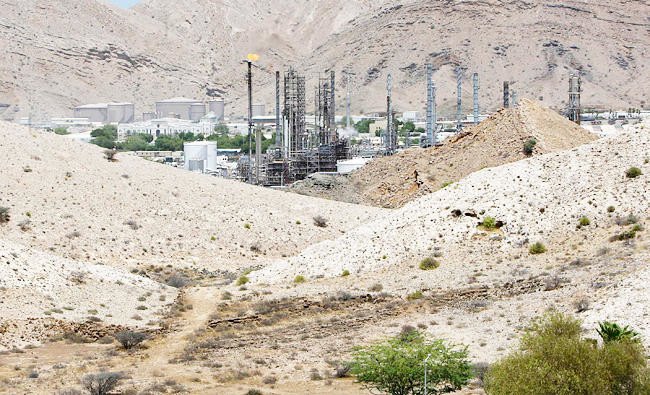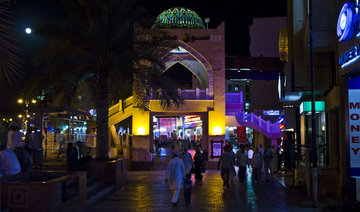LONDON: Oman will be among the countries in the Gulf region expressing the most relief about recovering oil and gas prices.
The Sultanate is more vulnerable to price shocks than others in the GCC as it holds less in the way of foreign exchange reserves.
“It doesn’t have the balance sheet strength of a country such as Saudi Arabia or Kuwait,” said Jason Turvey, a Gulf specialist at Capital Economics.
But Oman has something else up its sleeve that should act as a cushion in the years ahead — rising gas production.
The key to the Omani gas story is the giant Khazzan gas field, operated by BP in partnership with the Oman Oil Company on a 60/40 basis, respectively. The first phase of the project was completed in September and production is underway.
How important is Khazzan? It’s not a game changer as it won’t lead to an export bonanza — much of the increased gas will meet growing domestic consumption via ramped-up generating capacity that in turn will be used by industries being developed by Oman to cut its reliance on oil revenues.
When BP announced the first production from Khazzan in 2017, Isam bin Saud Al Zadjali, chief executive of Oman Oil, said: “This increment of gas supplies will provide feedstock for development of downstream and petrochemical industries.”
But Khazzan will definitely be a positive for the Omani economy going forward. The International Energy Agency (IEA) said in a 2015 report: “Oman has been facing gas shortages for some years, threatening the viability of its LNG exports and resulting in pipeline imports from Qatar.
“Khazzan will bring a much-needed 10 billion cubic meters per year (equal to one-third of the country’s current production), the IEA added.
Today, Oman exports liquefied natural gas (LNG) but imports some natural gas by pipeline from Qatar via the UAE.
“Developing tight gas from the country’s Khazzan field will partially offset natural gas imports,” said a 2017 report by the US Energy Information Administration (EIA).
So, Oman will benefit on two fronts. On the one hand, as the country’s domestic demand rises, it will need to import less gas, but as Khazzan is developed further it should be able to lift exports incrementally. At the same time, rising gas prices, which have gone up in tandem with oil, will also act as a growth catalyst.
Glen Ransom, Control Risks Middle East analyst, put it this way in an interview with Arab News: “The Khazzan gas project is vital to Oman as it will provide additional gas needed to power domestic electricity generation and energy-intensive industries that are part of plans to diversify the economy away from oil. The project is likely to boost export capacity, but increasing domestic consumption over the longer term will limit its ability to become a significantly larger gas exporter than it is today.”
More broadly, he added that Muscat is expected to use increased revenues in 2018 to support further investment and public sector spending, such as salaries and subsidies, rather than to reduce its deficit.
Turvey at Capital Economic told Arab News: “Large current and budget account deficits have opened up in Oman since 2014 when the oil price collapsed. What made matters worse, the country squirreled away a much smaller amount of the windfall during the oil boom.”
He estimated that Oman’s foreign exchange reserves amounted to 50 percent of GDP, while for KSA the figure was around 80 percent.
Kuwait was at the other end of the spectrum, with reserves four or five times in excess of GDP, he said.
Turvey added: “Before the price crash, Oman needed a break-even oil price of between $100/bbl and $110/bbl.
“But with the successful implementation of austerity measures and cuts to some subsidies, that number had come down to between $80/bbl and $90/bbl.”
In KSA, the number had been cut from more than $100/bbl to around $75/bbl, according to Turvey.
The Central Bank of Oman’s 2016 annual report, released in June 2017, illustrated the country’s continuing dependence on hydrocarbons. It said: “Oil and gas revenues as a percentage of GDP stood at 27.4 percent and accounted for 68.2 percent of government revenues and about 57.9 percent of total merchandise exports (including re-exports) during the year.
The report said: “In view of potential comparative advantage of value-added hydrocarbon-based industries in the country, the government has adopted an investment strategy that is based on promoting many petrochemical and energy-intensive industries (such as power generation and water salination). This policy is one of the major pillars of the country’s economic diversification initiatives.”
Richard Boxshall, an economist at PwC in Dubai, expects “cleaner” gas to account for a growing proportion of Oman hydrocarbons production, further diversifying energy resources away from oil.
He said: “Gas accounted for 30 percent of revenues in 2016. In previous years it has been lower, circa 15-20 percent. This was mainly because gas prices have been more stable than oil prices. Nevertheless, it shows that gas has become more important in terms of revenues even before the new capacity in Oman has come on board.”
Phase One of the Khazzan development is made up of 200 wells feeding into a two-train central processing facility. Phase One production is expected to plateau at 1 billion cubic feet of gas per day (bcf/d).
Once the second phase of the Khazzan is fully up and running, production is expected rise to 1.5 bcf/d. In total, about 300 wells are expected to be drilled over the estimated lifetime of the Khazzan field. Phases One and Two will together develop an estimated 10.5 trillion cubic feet of recoverable gas resources, said BP in a statement.
Going forward, the World Bank said: “Economic growth (in Oman) is set to modestly recover over the medium term. In 2018, a boost in the hydrocarbon sector will drive the recovery — as the “OPEC plus” restrictions on oil supply are lifted and the Khazzan gas project expands production capacity.
GDP growth is projected to rebound to 2.9 percent by 2019, said the World Bank.
However, with rising production levels and a growing petrochemical sector- which relies on liquefied petroleum gases and natural gas liquids –“the country is unlikely to significantly alter its dependence on hydrocarbons as a major revenue stream in the short term, according to EIA.















